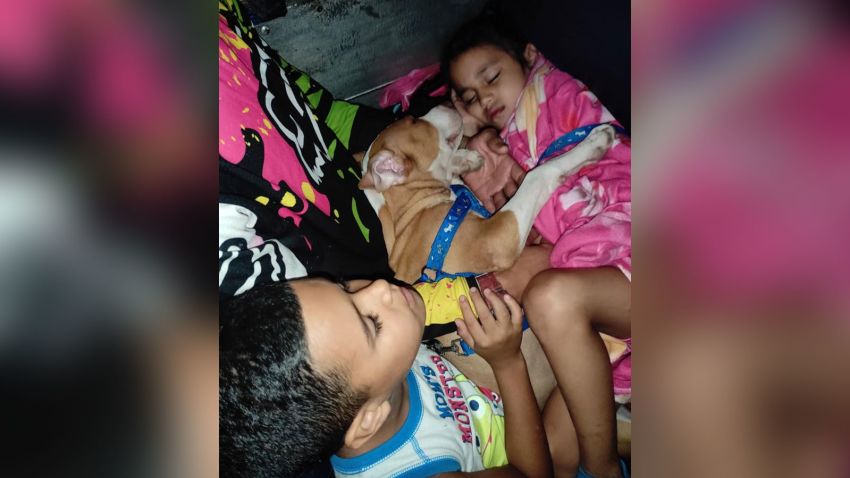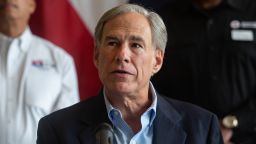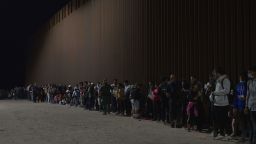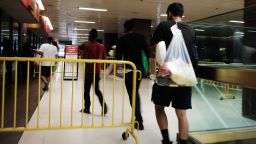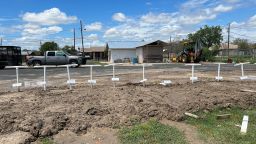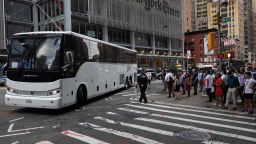Jessica Flores stepped out of the Port Authority Bus Terminal with her husband and their 6-year-old daughter into the unfamiliar heart of Manhattan, where giant billboards sparkled under a sweltering late summer sun.
The sidewalks and traffic lanes along bustling Eighth Avenue were packed when the family emerged carrying plastic bags with all their belongings. Visitors, homeless people and commuters clutching cups of iced coffee crammed the street. Nearby, pedestrians dodged yellow cabs, double-decker tour buses and electric bicycles.
“Where did all these people come from?” Flores, a 27-year-old undocumented immigrant from Venezuela, remembered thinking last month upon seeing New York up close for the first time. “It was different from everything we saw on the way here.”
Indeed, a wave of undocumented immigrants and asylum seekers arriving in New York in recent months – fleeing economic insecurity and political upheaval in Central and South America – have seen much during their months-long journey across more than a half dozen countries. They have traversed a remote, lawless jungle and rugged mountains, at times passing the corpses of others who perished along the way. They described roadblocks manned by rogue police officials or members of criminal and paramilitary groups who extorted money from them.
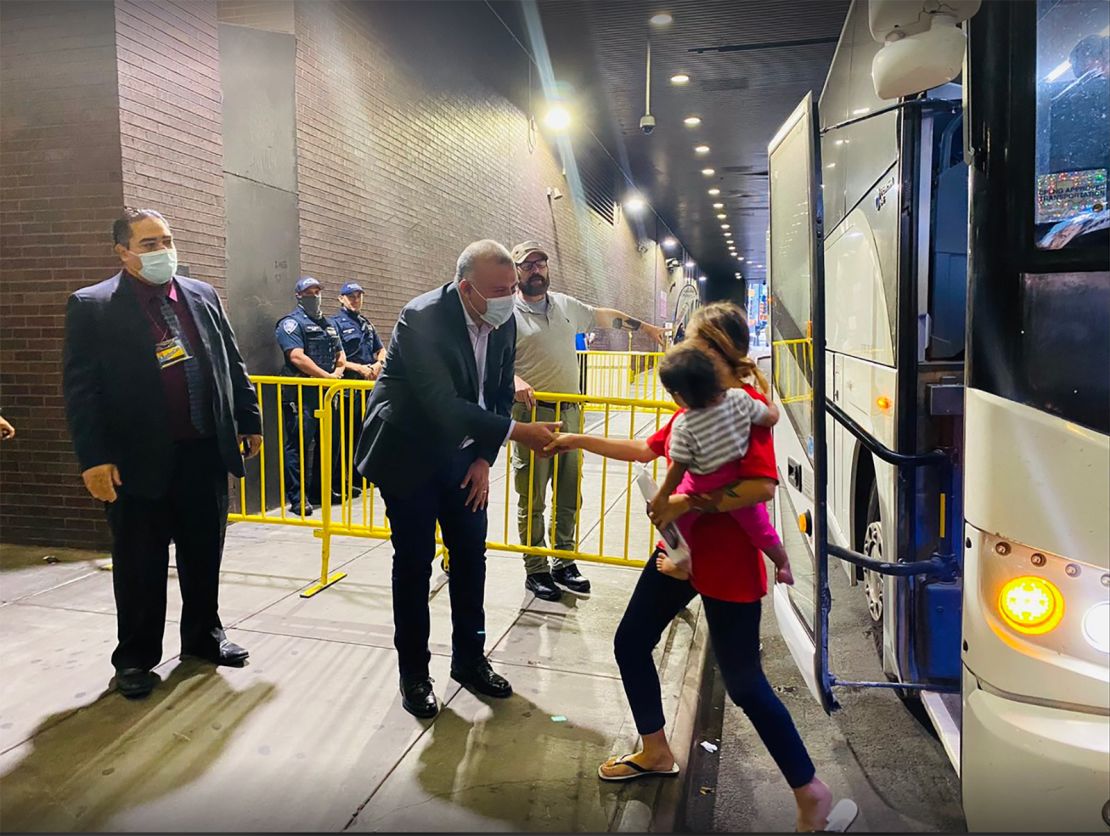
Hungry and tired, they reached the southern border and crossed into the United States, in Texas and other states on the Mexican frontier. After processing and receiving dates for asylum hearings, they were released by immigration officials to local charities and, in some cases, offered free trips to New York.
Thousands have chosen the Texas-chartered buses to New York City and the nation’s capital – where they have no connections or know where to turn for help. Many, like Flores and her family, ended up in New York’s overburdened shelter system, embarking on yet another uncertain odyssey as the newest members of the ever burgeoning homeless population.
“A social worker at a Texas shelter told us there were free buses to New York,” Flores said on the phone from a city-run shelter for families in the Bronx. “We got on the next one and here we are.”
NYC makes new arrivals ‘our priority’
By the last week in August, Texas had bused nearly 9,000 migrants to New York City and Washington, DC, as Gov. Greg Abbott, a Republican, has sought to highlight what he said is the Biden administration’s failure to secure the border.
Texas reported on August 26 that more than 7,400 migrants had been transported by the state to DC since April, and more than 1,500 to New York City since August 5, providing what Abbott’s office termed “much-needed relief to our overwhelmed border communities.”
Abbott’s office did not immediately reply to CNN’s request for comment.
On Friday morning, three buses from Texas delivered another 110 migrants to New York, city officials said.
Texas has spent more than $12 million busing migrants to Washington and New York as of August 9, according to figures from the Texas Division of Emergency Management. Abbott’s office has said migrants are transported out of state only with their written permission but it’s unclear whether they’re given other options.
Abbott and others who favor increasing immigration restrictions argue that Biden administration policies have provided an incentive for more people to cross the border illegally. Some Republican candidates have pushed the narrative of a migrant invasion as midterm elections approach, pledging they’ll do more to crack down on illegal immigration.
On Wednesday, Abbott added Chicago to the list of cities where his administration is busing migrants.
“President Biden’s inaction at our southern border continues putting the lives of Texans — and Americans — at risk and is overwhelming our communities,” Abbott said in a statement.
Chicago received 75 Venezuelan migrants from Texas – who were dropped off at Union Station Wednesday night, according to Mayor Lori Lightfoot. She called Abbott “a man without any morals, humanity or shame.”
“This is not something that we budgeted for, but it’s something that we must do. So we will figure out the finances,” Lightfoot said Thursday, adding that more buses were expected.
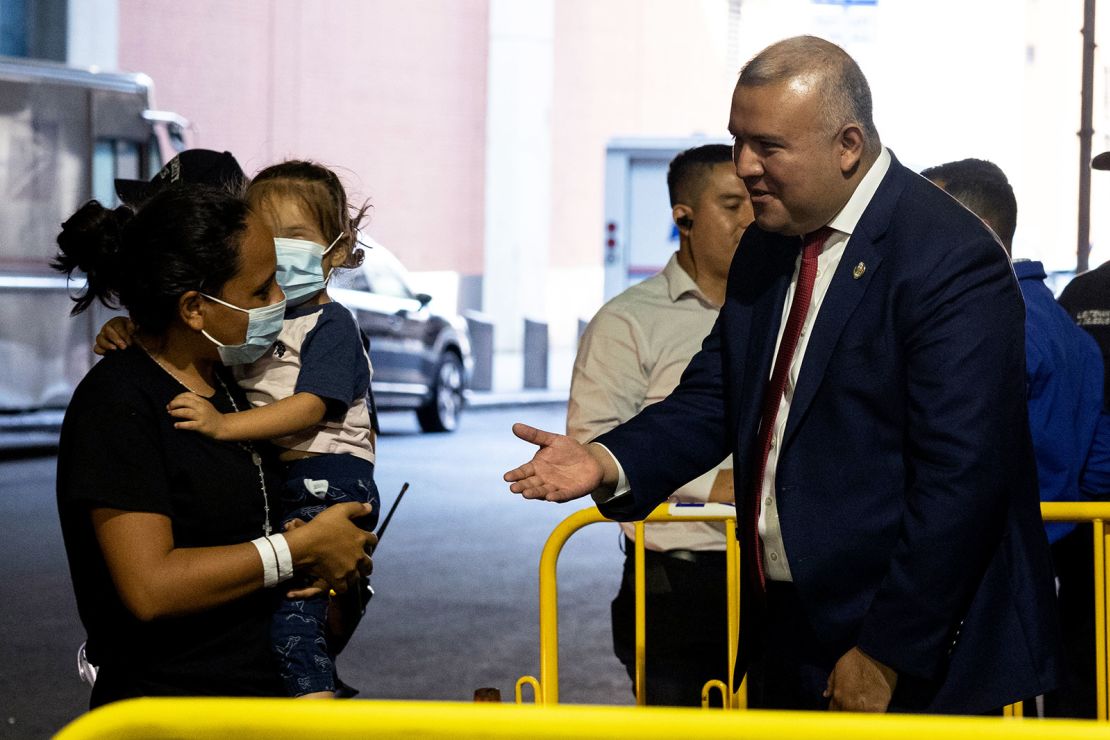
New York City has processed about 8,800 migrants in its shelter system since April, with about 6,700 still in shelters, a city official told CNN Thursday. City officials had said the figure included more than 1,000 children. Many migrants come to New York on their own with the financial assistance of nonprofits.
Department of Homeland Security Secretary Alejandro Mayorkas said Abbott’s actions are throwing the federal system for processing migrants “out of whack” and criticized the governor for not coordinating with federal authorities.
Generally, migrants are processed by authorities, released and allowed to move throughout the US while they await immigration court proceedings. They are often released in Texas and other border states, and make their way to other parts of the country.
The busing campaign has led to sparring between Abbott and New York Mayor Eric Adams, a Democrat whose administration has accused the governor of using human beings as political pawns and whose city has been long considered a sanctuary for migrants. The mayor has asked the federal government for more resources, including housing assistance. The White House said it is in touch with Adams and committed to FEMA funding and other support.
“These individuals and families arrive hungry, thirsty and some need medical attention,” Manuel Castro, Commissioner of the Mayor’s Office of Immigrant Affairs, told CNN Tuesday. “So that is our priority – to make sure that these people are being supported and in comfort because what they’ve been through is just so devastating.”
Castro himself crossed the US-Mexico border with his mother when he was 5. He has been greeting migrants at the much maligned Port Authority terminal, a notorious commuter gateway once called “a hall of unfathomable nightmares” by the website Failed Architecture.
A quest to give them their ‘humanity back’
While city officials say they were initially caught off guard with the almost daily, unannounced arrival of charters, they mobilized – with the help of nonprofits – to set up a sectioned-off receiving area at the terminal. The migrants receive medical attention and rapid Covid-19 tests, food, clothing, prepaid phones, toiletries, legal assistance and transportation to temporary shelter. Many arrive without money, with just the clothes on their backs.
“We know the trauma these families are going through but this is extra what’s happening here,” said Jose Lopez, co-executive director of the immigrant advocacy group Make the Road New York.
The nonprofit has volunteers at the terminal, distributing phones and cash assistance at tables set up in the receiving area.
“Many of these families from Venezuela have traveled months on their feet and across the Rio Grande to get here. That is a treacherous trip. And imagine doing that with a three-year-old,” Lopez said.
“I have a two-year-old and a five-year-old at home and the first family I met had a three-year-old girl who just looked around and had no understanding of what was happening. I needed to step away from the table for a minute. Her family was asking for resources. I asked the little girl what she had picked up from the tables. She said, ‘I just have Mami and Papi.’ ”
Last week, at 6:45 a.m. on Thursday, the first two buses of the day pulled up alongside the terminal, one block west of Times Square, the so-called “Crossroads of the World.” Castro and community activists greeted passengers outside the buses with handshakes and applause – a procession of children covered in blankets, mothers clutching toddlers, and young men carrying backpacks and wearing flip flops. One man needed a wheelchair to get inside. Another migrant was taken away in an ambulance.
“Dozens of volunteers … show up early in the morning and try to give those asylum seekers their humanity back,” said Alexander Rapaport, a founder of Masbia, a Jewish nonprofit that provides meals for the new arrivals.
Most migrants end up in the city’s overcrowded homeless shelter system, which housed more than 50,000 people as of Thursday night, according to the nonprofit Coalition for the Homeless, which monitors shelter census reports. Some wait hours to be reunited with relatives who live in the area. Others, looking confused and disappointed, tell volunteers they believed they were headed to another city or state. New York is using 17 hotels as emergency shelters, a city official told CNN.
For now, the migrants will have to rely on a vast, longstanding social safety net created by nonprofits and city agencies, easing access to government resources and benefits for housing, healthcare and food.
‘We could not stay there’
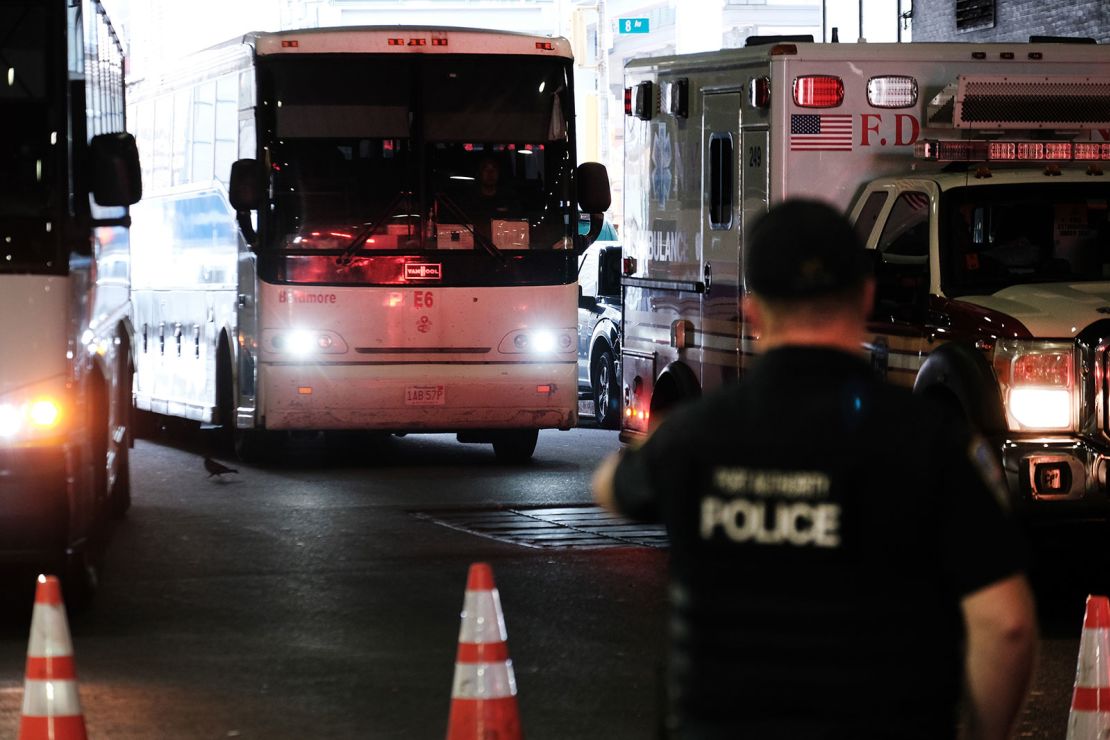
Flores and her family have been staying at a crowded family shelter in the Bronx, where, she said, the language barrier makes it difficult to communicate with staff and residents.
When they arrived in Texas last month, she said, they were released without money and no place to go. A social worker at a church-run shelter offered them free bus tickets to New York.
The family left Maracaibo, on Venezuela’s northwest coast, on May 18.
“We were going hungry,” she said. “We could not stay there. There is nothing. If you get sick, you die… There is no future there. The future is here.”
Flores and other migrants described the days it took to cross the Darién Gap, the more than 60 miles of dense rain forest, steep mountains and swamps along the Colombia-Panama border. It is one of the most dangerous migration routes in the world.
“We spent seven days in the jungle with another family,” Flores said. “A guide abandoned us but we were fortunate to make our way out.”
By the time Flores’ family reached the northern Mexican city of Piedras Negras, across the border from Eagle Pass, Texas, she said they were exhausted, hungry and penniless – having paid hundreds of dollars at roadblocks from Guatemala to Mexico.
Last Thursday, Venezuelan asylum seekers Manaure Fernandez, 25, and Wilber Salvatierra, 23, emerged from the bus terminal with plastic bags after stepping off a Greyhound bus from San Antonio. A charity had paid for the $270 bus fare, they said.
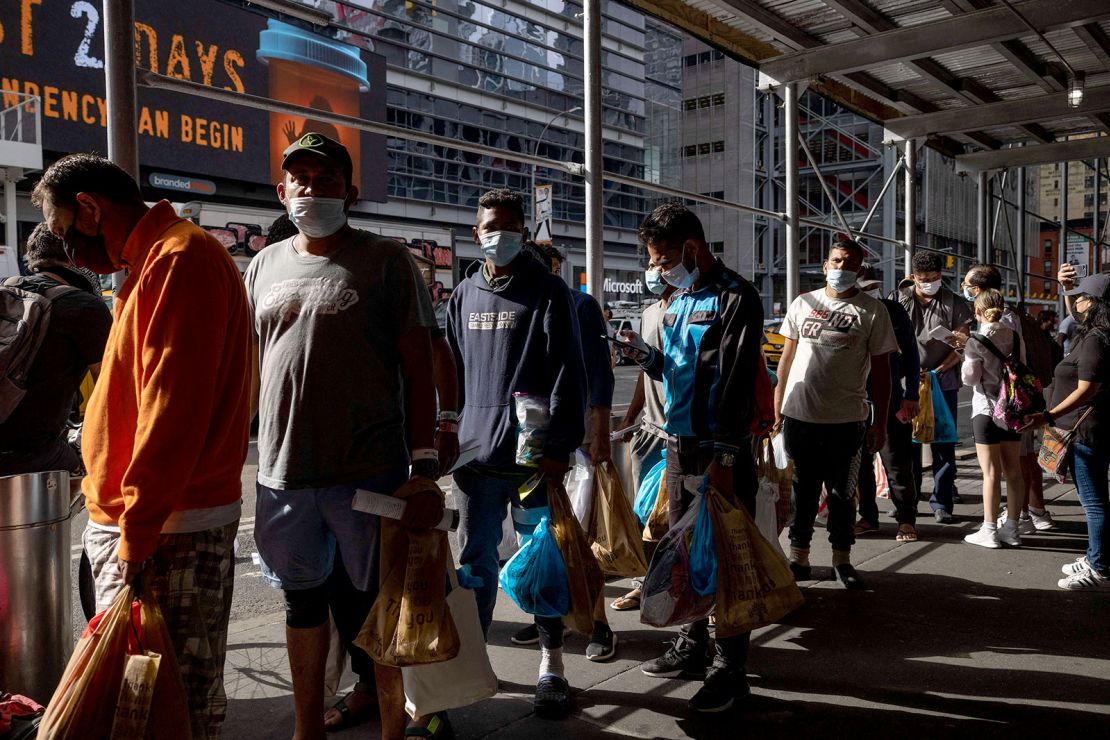
Fernandez said he left Venezuela in late May. He was robbed of all his money in the Darién Gap – about $800 – by three masked armed with rifles. The men told the migrants said they were part of a paramilitary group. Fernandez said he walked most of the way to the US border – a journey of roughly 2,500 miles over Central America alone.
“On foot I crossed Costa Rica, Nicaragua, parts of Guatemala and parts of México,” he said. “Sometimes people helped with food and cash.”
“There were many good people along the way,” said Salvatierra. “In Panama, people stopped on the road and gave us food and water. They said they could not take us because they could be jailed for transporting migrants.”
Salvatierra said he had migrated to Chile in 2018, supporting himself as well as his parents back home by working construction jobs. He raised about $1,400 and decided to head north in late June.
“The money ran out by the time I got to Guatemala,” said Salvatierra, who clutched a miniature copy of the New Testament.
“It was always in my hand,” he said the small book. “I’m not religious but I have faith. I carried it from Chile to Peru, from Ecuador to Colombia, across the Darien and Panama, from Costa Rica to Nicaragua, from Honduras to Guatemala and Mexico.”
The two migrants, who met in Texas, and others said they encountered bodies along desolate stretches of the Darién Gap. Those who were injured or ill were usually left behind to die, they said.
“We embarked across the Darién with a total 339 people,” Salvatierra said. “About 230 reached Panama. Many died. We saw bodies … on the side of rivers. A friend traveling with his young son said he could not stop thinking of a dead child he saw.”
Fernandez and Salvatierra, standing under the glittering billboards near Times Square, asked a stranger if he knew of available jobs in the city. They’re staying at the intake shelter for single adult men in Manhattan until beds can be found in a longer-term facility.
“We’re fortunate to have made it this far,” said Salvatierra, clutching his New Testament and court papers for his first immigration hearing next month, “even if we don’t have anyone here.”
CNN’s Polo Sandoval, Rosa Flores, Priscilla Alvarez, Catherine E. Shoichet, Christopher Hickey, Omar Jimenez, Zenebou Sylla, Samantha Beech and Andy Rose contributed to this report.
